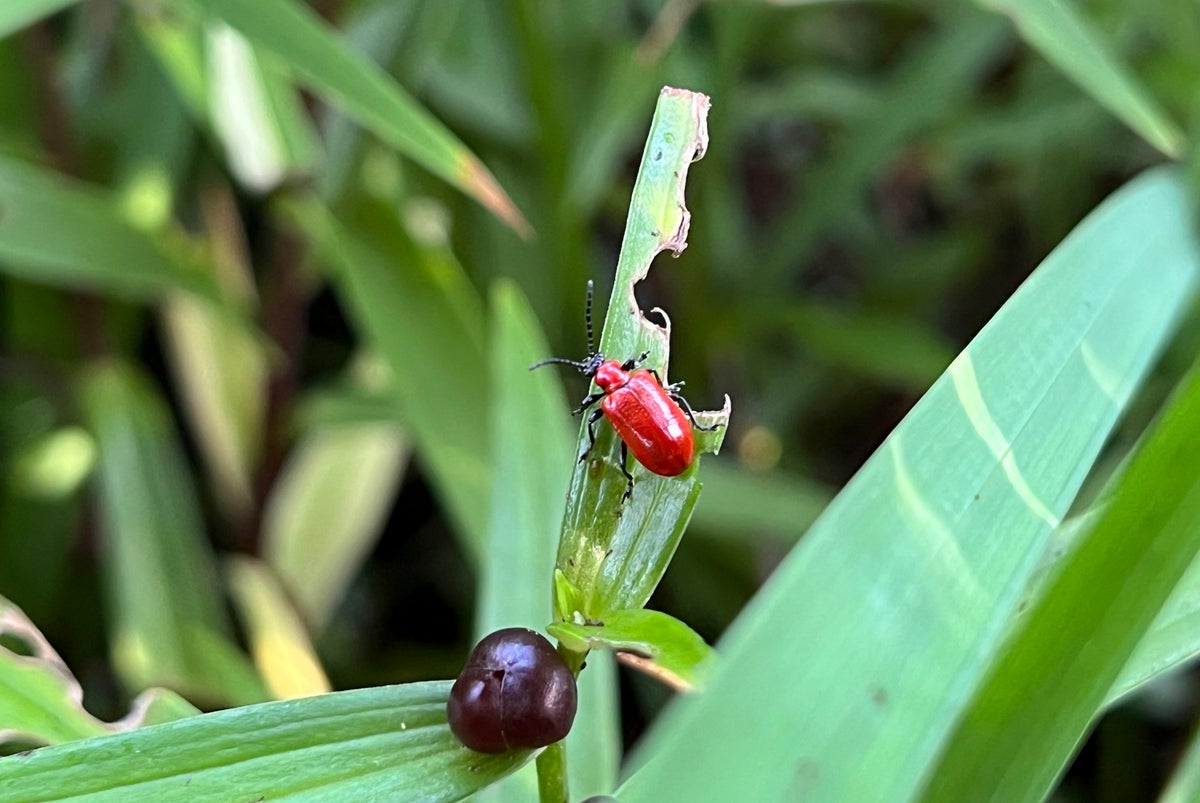
Every morning, I head outside, coffee in hand, and usually in my pajamas, to check on my plants.
“Who’s thirsty? Who needs a trim?” I ask, tending to their needs as I move from bed to bed.
Most days, the visit reveals pleasant changes, like the first Madame Julia Correvon clematis flower of the season or the emergence of a green, lumpy Voyager tomato that wasn’t there the day before. But sometimes, horror strikes.
As I assessed the Domingo, Voyager and RW Cephei tomatoes growing in my Earth Boxes one day last week, I noticed small, dark dots on their stems. Hoping they were soil specks, I zoomed in on them with my phone’s camera and discovered three different species of aphids feasting on them. I couldn’t see their piercing, sucking mouthparts, but I knew they were embedded in the vulnerable tissue of the 3-foot-tall plants I’d lovingly started from seed in March.
When combatting garden pests and diseases, it’s important to act quickly. Left unchecked, they can quickly escalate, resulting in decreased vigor, diminished flower and fruit production, or even complete decimation.
My course of action always begins with the most benign treatment possible, and I only escalate if necessary. Even then, I have my limits, as I’d rather sacrifice a flower or vegetable plant than use harsh chemicals.
In the case of my tomatoes, since I’d caught the aphids early, I was able to rinse them off with a hose, rubbing the stubborn ones off with my fingers under a moderate stream of water. They haven’t returned, but I look for them every day, just in case.
Had the invasion been severe or the water-and-rubbing method ineffective, I would have applied a spray of Neem, which kills aphids by smothering. The organic oil, derived from the seeds of the Neem tree, is safe to use on edibles and is nontoxic to people, pets and birds. Still, it should be applied after dusk when beneficial insects are less active.
That same day, I found adult scarlet lily beetles on my Asiatic lilies. They’d never shown their faces in my garden before, so, frankly, I was offended. The red insects feed on the leaves, stems, buds and flowers of all true lilies and fritillaries.
In their larval stage, which I missed in spring, they cover themselves in excrement. As you might imagine, that renders them unappetizing to predators. The coating also serves as a shield to protect them from pesticides, making it difficult to eradicate them. It’s a cool defense mechanism – but also, eww!
Because I didn’t notice the small poop-coated, ravenous larvae earlier in the season, they completely destroyed some of my plants, which stood stripped, brown and shriveled at the back of the bed. To prevent more carnage, I had to remove the adults that populated the remainder of my lilies, so I tapped them off the stems into a bucket of soap- and vinegar-laced water.
On my way back into the house, I stopped to check the rhododendron by the front door, which was attacked by azalea bark scale last summer. Sure enough, the white, fuzzy insects had made a comeback. Some of the foliage was infested, so I trimmed it off. But because most of the leaves hosted just a few of the pests, I was able to eliminate them by dabbing each with a cotton swab that I’d dipped in rubbing alcohol.
Had I not noticed until all the leaves were covered in scale, the alcohol method would have become impractical -- or impossible -- to carry out. In that case, the sap-suckers’ feeding could have led to yellowing, wilting, stunting and, in severe cases, death of the plant.
My early interventions slowed or stopped infestations that could have been fatal. The same would have held true for diseases, many of which also respond better to early treatments.
Take blossom end rot, a disorder of tomatoes, peppers, eggplants and squash caused by insufficient calcium, often the result of irregular watering practices or drought stress. The first symptom is a water-soaked spot on or near the blossom-end (bottom) of the fruit. As the spot grows, the affected area sinks and turns brown or black.
Catch it early, and you can save your crop by drenching the entire plant with a calcium spray, which almost immediately corrects the deficiency. Most of the time, new fruit produced after treatment is healthy. If it isn’t, a second dose should do the trick.
Monitoring ornamentals like lilacs, roses, asters, phlox, bee balm, peonies and black-eyed Susans, and crops like melons, pumpkins, squash, eggplant, tomatoes, peppers and artichokes for the presence of a dusty white leaf coating will give you a leg up on a fungal infection called powdery mildew. The disease can result in plant weakening, stunting and leaf drop if it escapes your attention.
Early treatment with a spray made by mixing 3 tablespoons each of baking soda and light horticultural oil into a gallon of water can stop spores from spreading throughout the plant or to others nearby. Neem oil is another early-treatment option that provides a similar benefit.
The best cure is prevention, and the best way to keep your plants healthy is with frequent search-and-destroy missions. They don’t require much effort, and if you’re anything like me, you don’t even have to get dressed.
—-
Jessica Damiano writes the award-winning Weekly Dirt Newsletter and regular gardening columns for The AP. Sign up here to get weekly gardening tips and advice delivered to your inbox.
__
For more AP gardening stories, go to https://apnews.com/hub/gardening.







